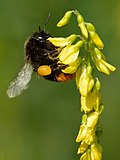Melilotus officinalis
Melilotus officinalis, also known as yellow sweet clover, yellow melilot, ribbed melilot and common melilot, is a species of legume native to Eurasia and introduced in North America, Africa, and Australia. It belongs to the family Fabaceae and the genus Melilotus.
Description[edit]
Melilotus officinalis is a biennial plant that grows to a height of 4-6 feet. It has a deep taproot system and a smooth, erect stem. The leaves are trifoliate, with serrated edges. The flowers are small, yellow, and fragrant, arranged in a raceme. The fruit is a small, black pod containing a single seed.
Distribution and Habitat[edit]
Melilotus officinalis is native to Eurasia but has been introduced to other parts of the world, including North America, Africa, and Australia. It is commonly found in disturbed areas such as roadsides, fields, and waste places. It prefers well-drained soils and full sun exposure.
Uses[edit]
Melilotus officinalis has been used for various purposes throughout history. It has been used as a forage crop for livestock due to its high protein content. It is also used in traditional medicine for its purported healing properties. The plant contains coumarin, a chemical compound that has anticoagulant properties. However, when the plant is spoiled or fermented, coumarin can convert to dicoumarol, a potent anticoagulant toxin.
Cultivation[edit]
Melilotus officinalis is a hardy plant that can grow in a variety of soil types, although it prefers well-drained soils. It is drought-tolerant and can grow in areas with low fertility. It is usually propagated by seeds, which are sown in the spring or autumn.
Conservation Status[edit]
Melilotus officinalis is not considered a threatened species. However, in some areas where it has been introduced, it is considered an invasive species due to its ability to outcompete native plants.
See Also[edit]
| Invasive Plant Species | ||||||||||
|---|---|---|---|---|---|---|---|---|---|---|
This invasive plant species related article is a stub.
|
This medicinal plants related article is a stub. You can help WikiMD by expanding it.
-
Bombus lapidarius on Melilotus officinalis in Tallinn
-
Melilotus officinalis keels
-
Melilotus officinalis
Ad. Transform your life with W8MD's Budget GLP-1 injections from $75


W8MD offers a medical weight loss program to lose weight in Philadelphia. Our physician-supervised medical weight loss provides:
- Weight loss injections in NYC (generic and brand names):
- Zepbound / Mounjaro, Wegovy / Ozempic, Saxenda
- Most insurances accepted or discounted self-pay rates. We will obtain insurance prior authorizations if needed.
- Generic GLP1 weight loss injections from $75 for the starting dose.
- Also offer prescription weight loss medications including Phentermine, Qsymia, Diethylpropion, Contrave etc.
NYC weight loss doctor appointmentsNYC weight loss doctor appointments
Start your NYC weight loss journey today at our NYC medical weight loss and Philadelphia medical weight loss clinics.
- Call 718-946-5500 to lose weight in NYC or for medical weight loss in Philadelphia 215-676-2334.
- Tags:NYC medical weight loss, Philadelphia lose weight Zepbound NYC, Budget GLP1 weight loss injections, Wegovy Philadelphia, Wegovy NYC, Philadelphia medical weight loss, Brookly weight loss and Wegovy NYC
|
WikiMD's Wellness Encyclopedia |
| Let Food Be Thy Medicine Medicine Thy Food - Hippocrates |
Medical Disclaimer: WikiMD is not a substitute for professional medical advice. The information on WikiMD is provided as an information resource only, may be incorrect, outdated or misleading, and is not to be used or relied on for any diagnostic or treatment purposes. Please consult your health care provider before making any healthcare decisions or for guidance about a specific medical condition. WikiMD expressly disclaims responsibility, and shall have no liability, for any damages, loss, injury, or liability whatsoever suffered as a result of your reliance on the information contained in this site. By visiting this site you agree to the foregoing terms and conditions, which may from time to time be changed or supplemented by WikiMD. If you do not agree to the foregoing terms and conditions, you should not enter or use this site. See full disclaimer.
Credits:Most images are courtesy of Wikimedia commons, and templates, categories Wikipedia, licensed under CC BY SA or similar.
Translate this page: - East Asian
中文,
日本,
한국어,
South Asian
हिन्दी,
தமிழ்,
తెలుగు,
Urdu,
ಕನ್ನಡ,
Southeast Asian
Indonesian,
Vietnamese,
Thai,
မြန်မာဘာသာ,
বাংলা
European
español,
Deutsch,
français,
Greek,
português do Brasil,
polski,
română,
русский,
Nederlands,
norsk,
svenska,
suomi,
Italian
Middle Eastern & African
عربى,
Turkish,
Persian,
Hebrew,
Afrikaans,
isiZulu,
Kiswahili,
Other
Bulgarian,
Hungarian,
Czech,
Swedish,
മലയാളം,
मराठी,
ਪੰਜਾਬੀ,
ગુજરાતી,
Portuguese,
Ukrainian



